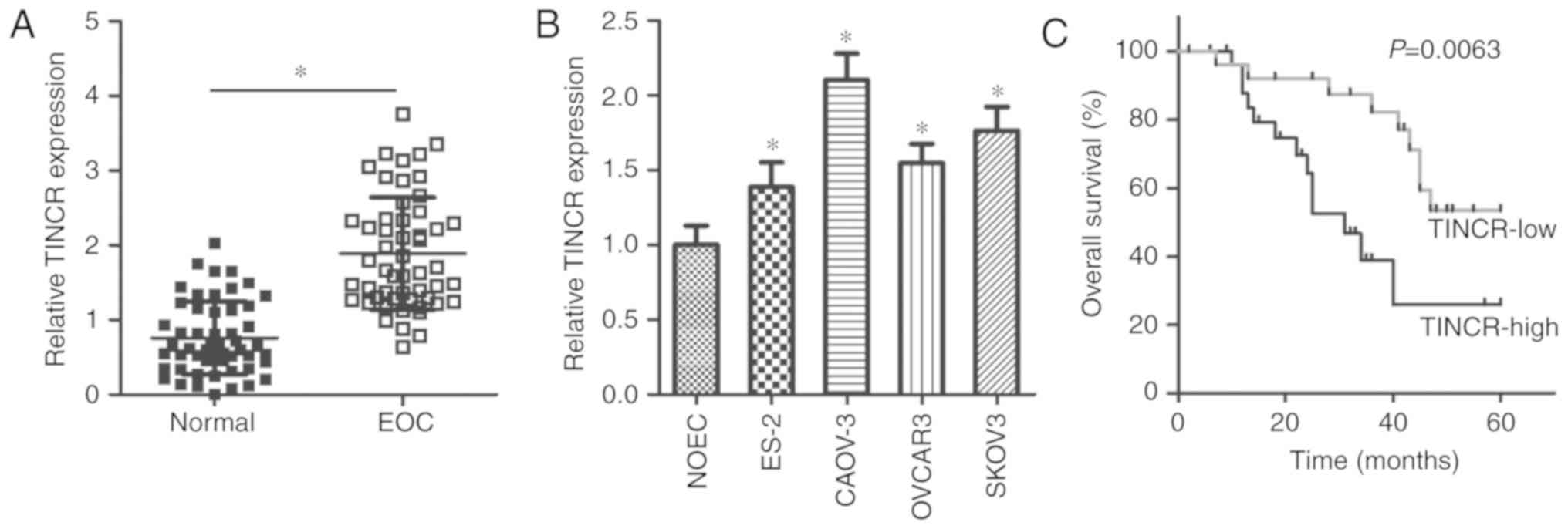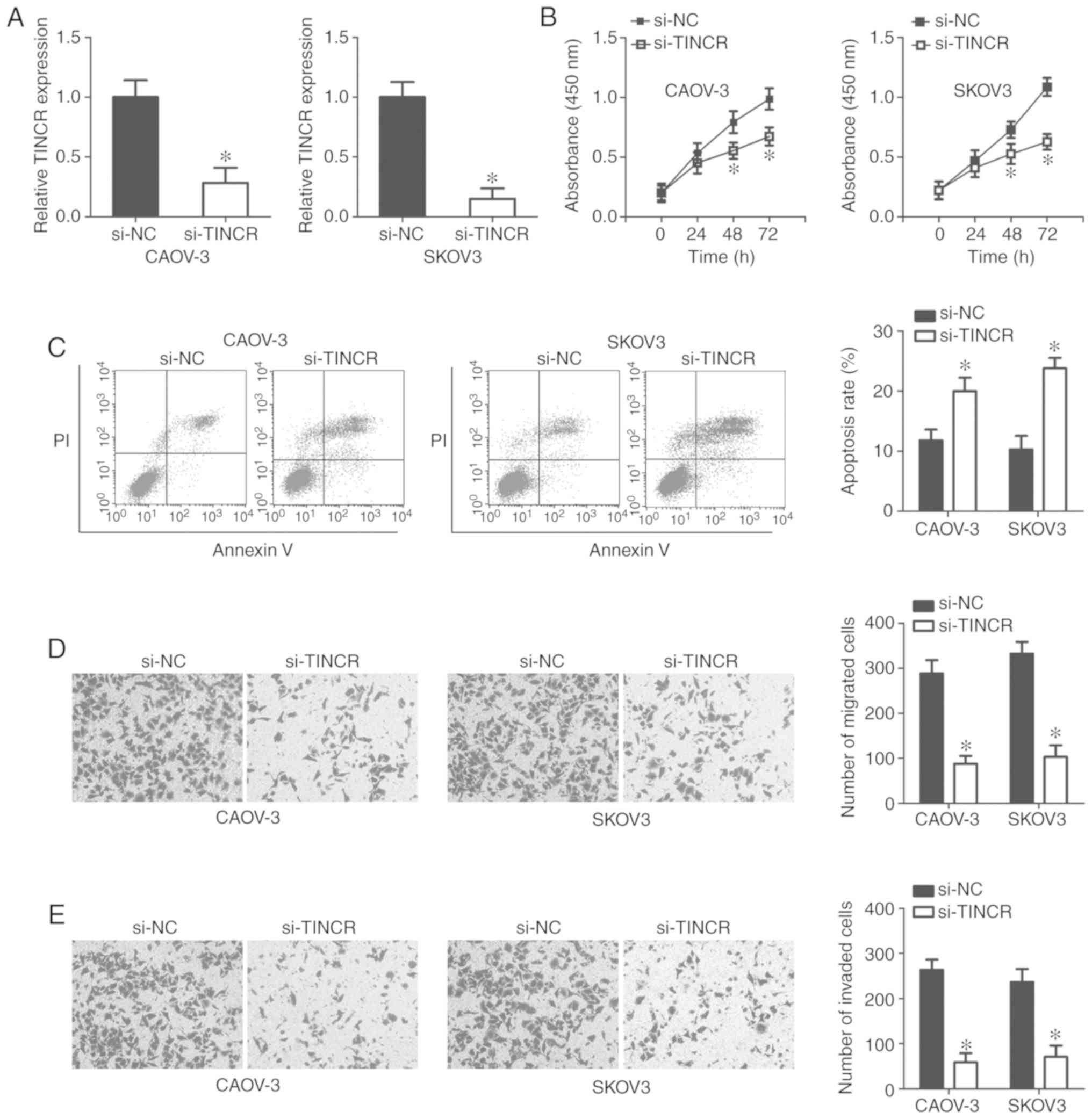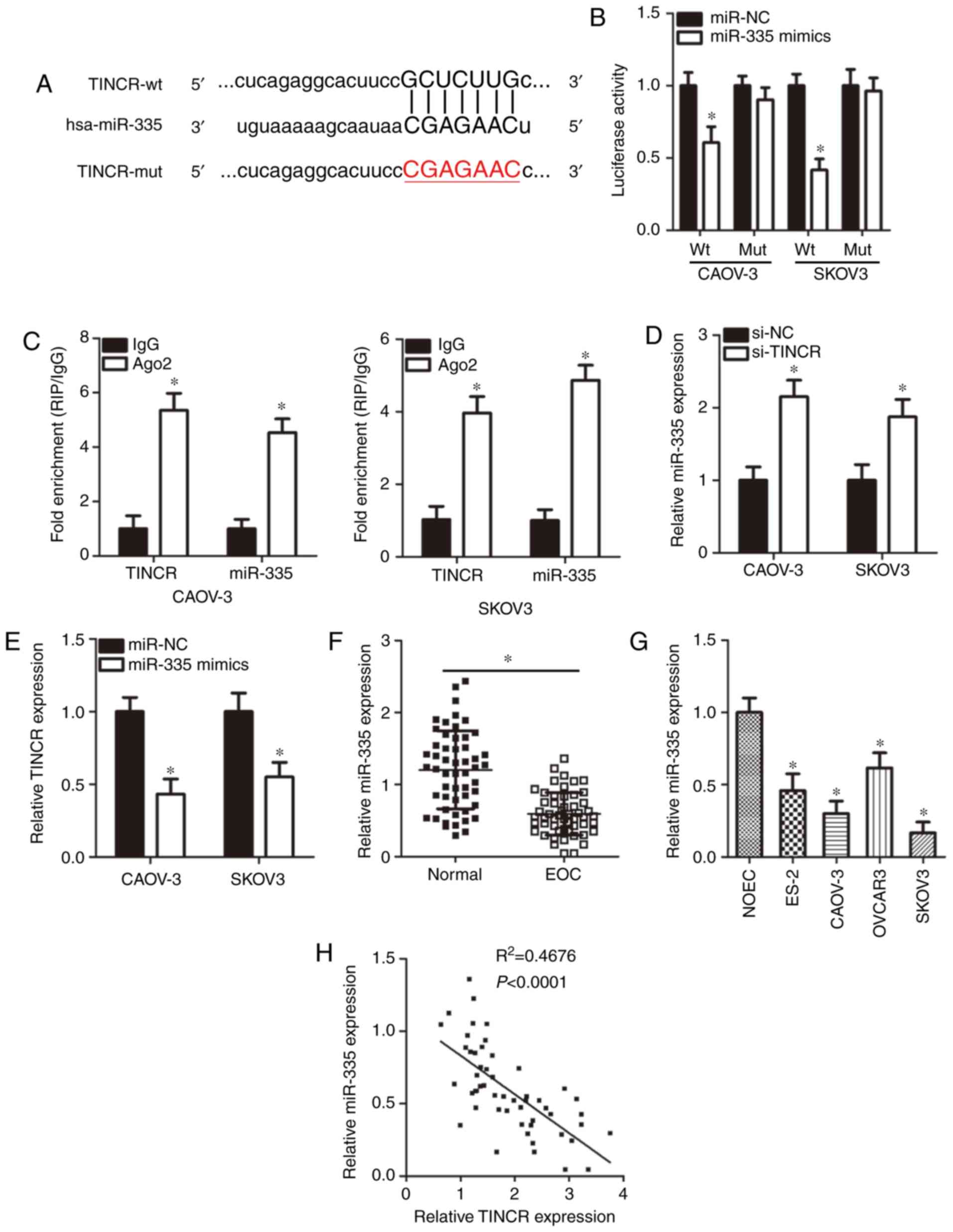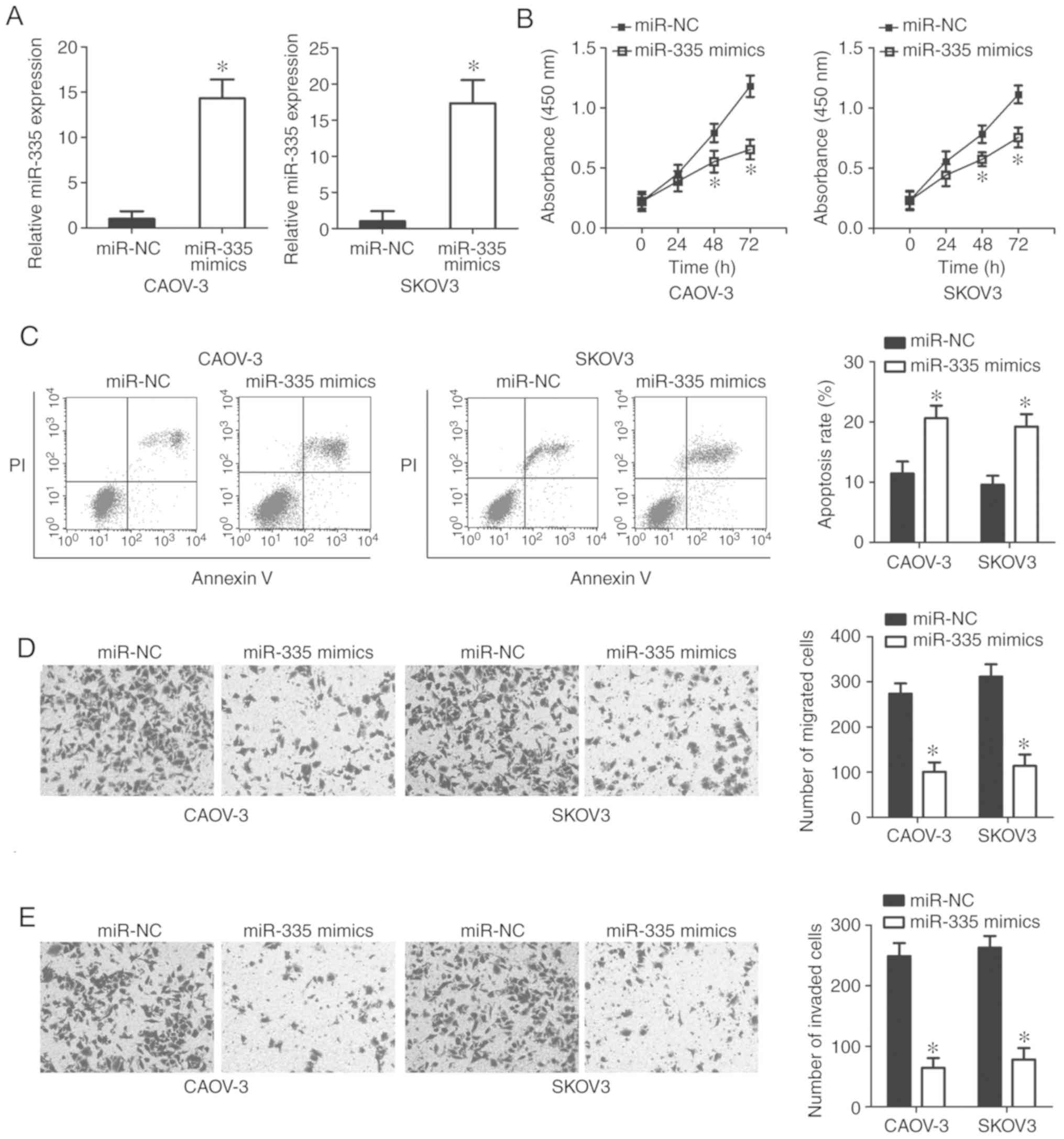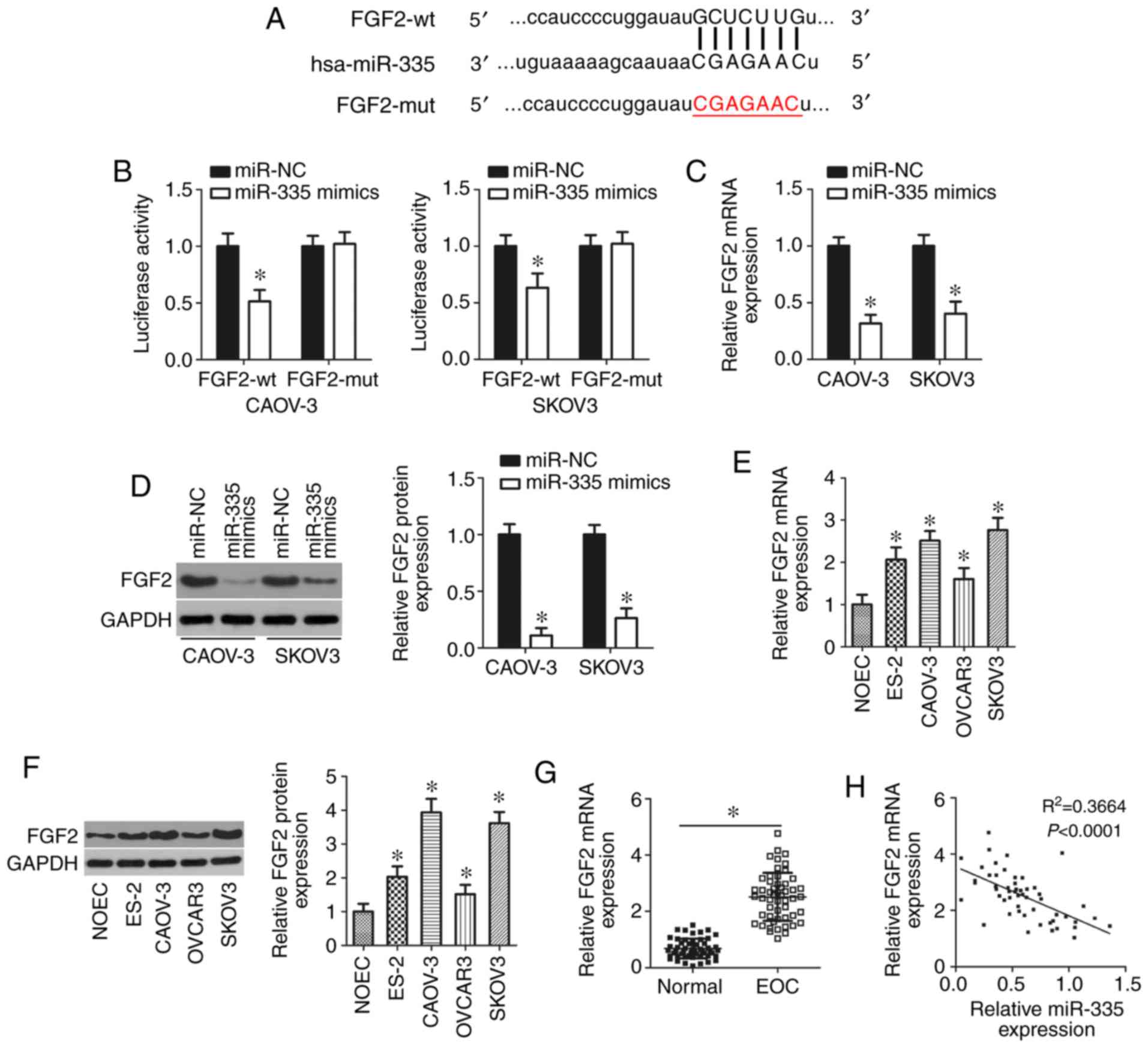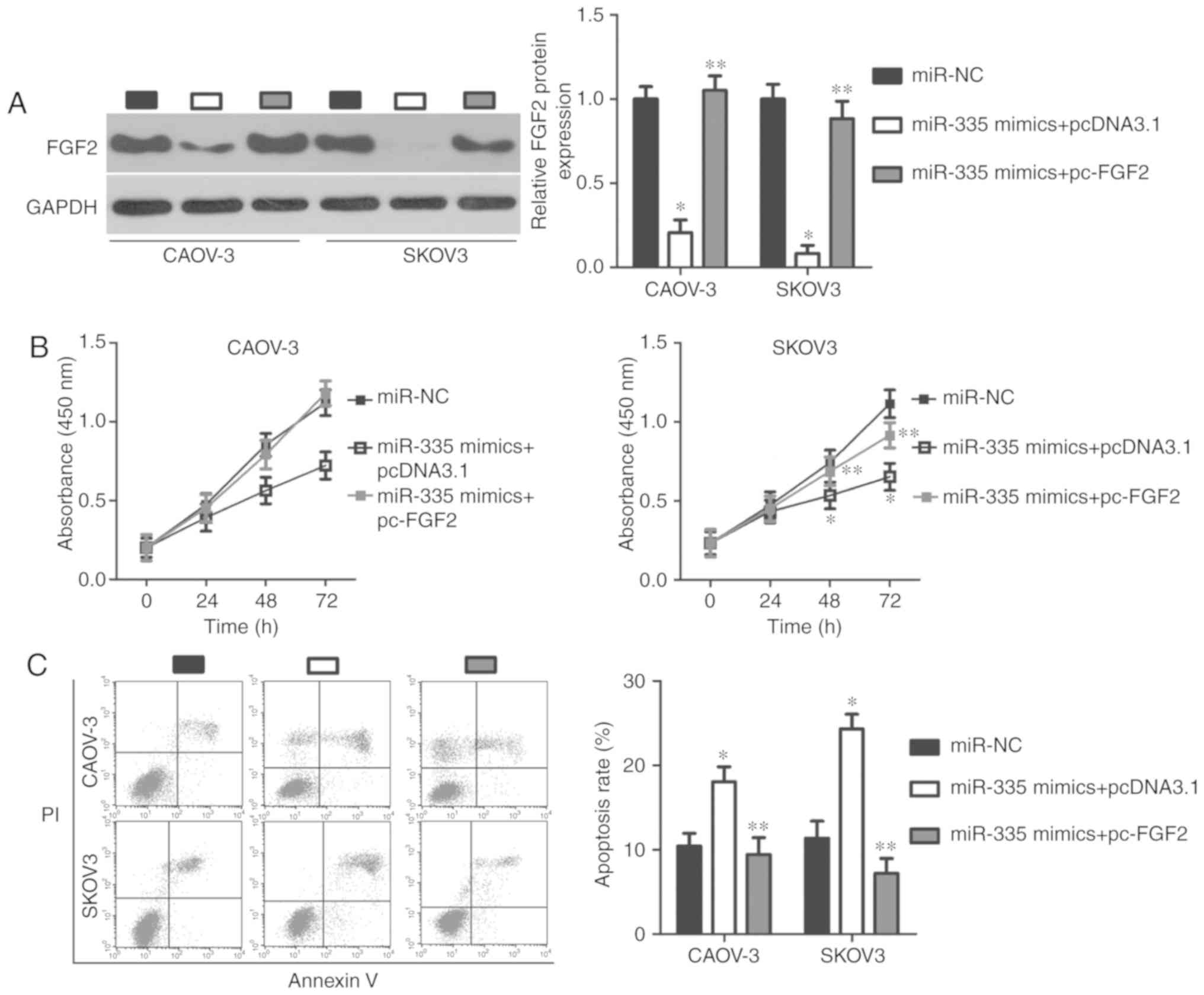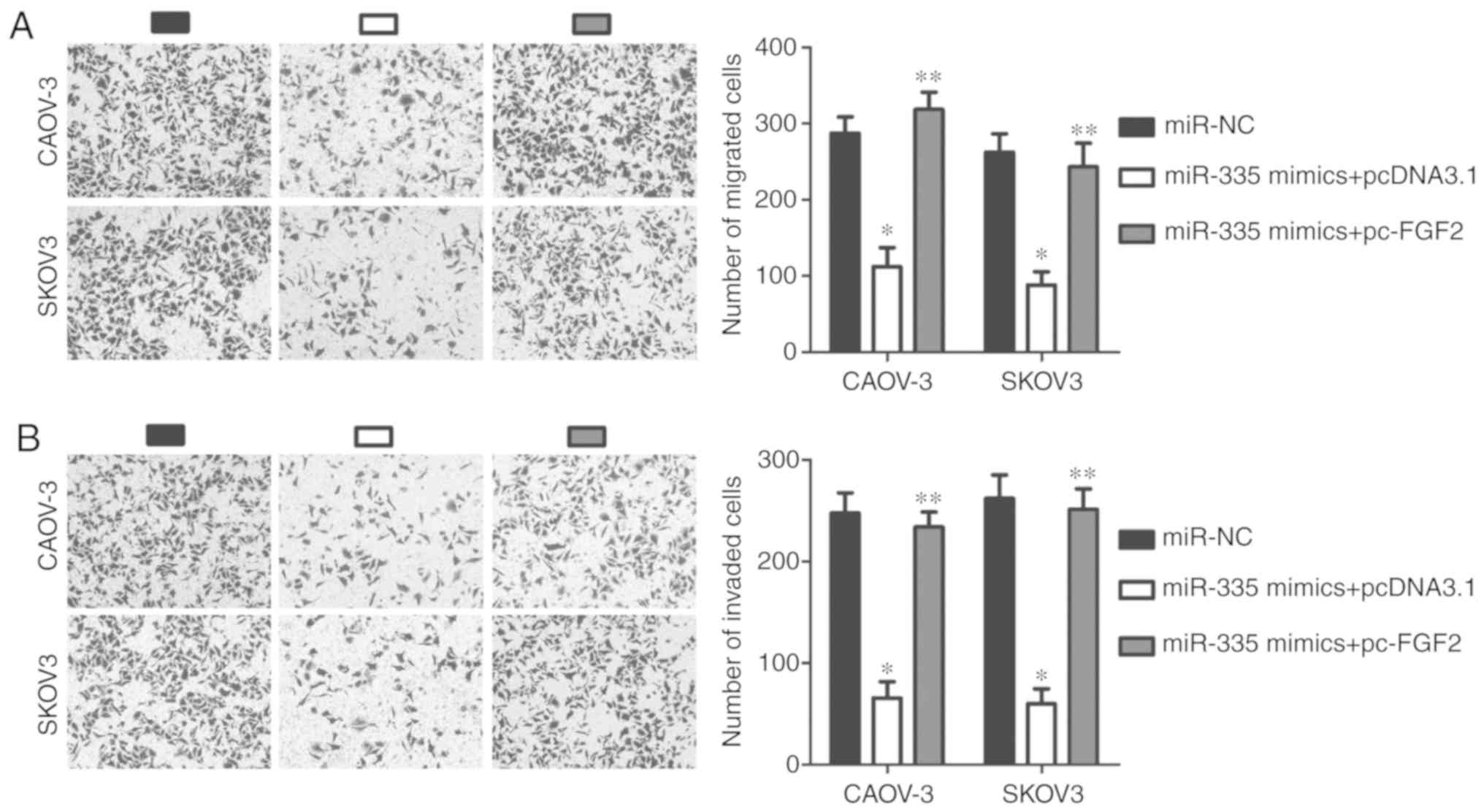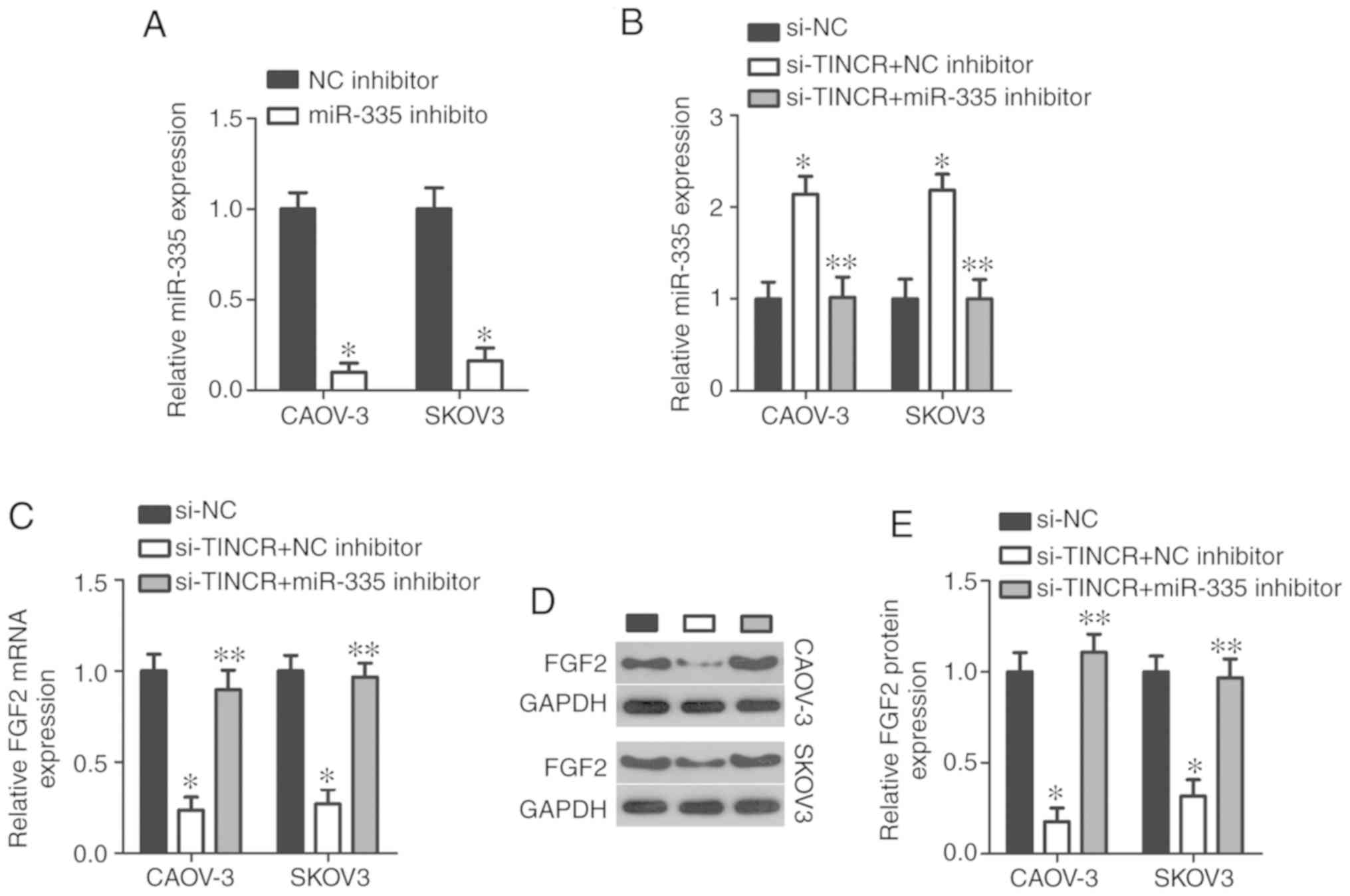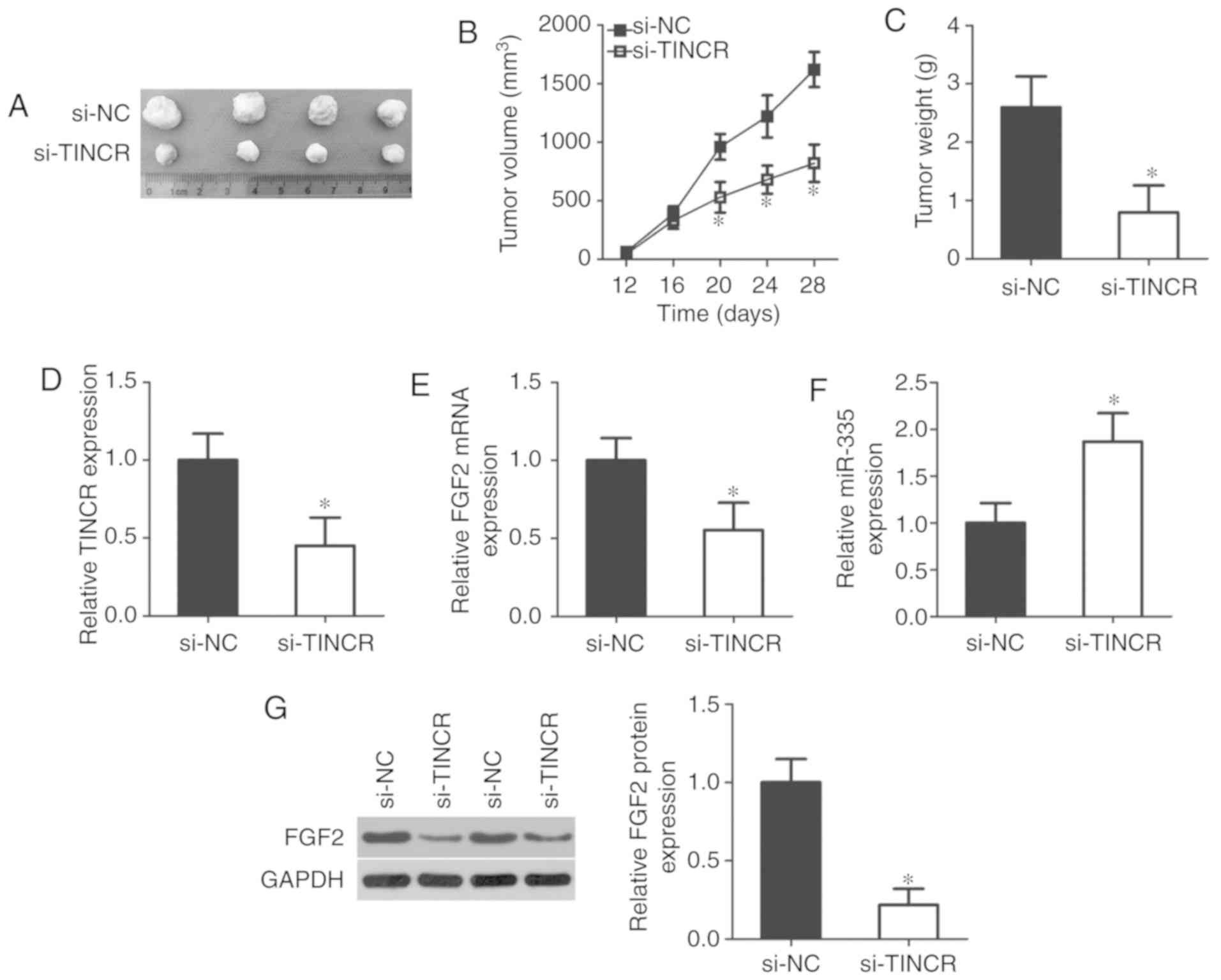|
1
|
Siegel RL, Miller KD and Jemal A: Cancer
statistics, 2019. CA Cancer J Clin. 69:7–34. 2019. View Article : Google Scholar : PubMed/NCBI
|
|
2
|
Ledermann JA, Raja FA, Fotopoulou C,
Gonzalez-Martin A, Colombo N and Sessa C: Newly diagnosed and
relapsed epithelial ovarian carcinoma: ESMO clinical practice
guidelines for diagnosis, treatment and follow-up. Ann Oncol.
24(Suppl 6): vi24–vi32. 2013. View Article : Google Scholar : PubMed/NCBI
|
|
3
|
Lupia M and Cavallaro U: Ovarian cancer
stem cells: Still an elusive entity? Mol Cancer. 16:642017.
View Article : Google Scholar : PubMed/NCBI
|
|
4
|
La Vecchia C: Ovarian cancer: Epidemiology
and risk factors. Eur J Cancer Prev. 26:55–62. 2017. View Article : Google Scholar
|
|
5
|
Candido-dos-Reis FJ, Song H, Goode EL,
Cunningham JM, Fridley BL, Larson MC, Alsop K, Dicks E, Harrington
P, Ramus SJ, et al: Germline mutation in BRCA1 or BRCA2 and
ten-year survival for women diagnosed with epithelial ovarian
cancer. Clin Cancer Res. 21:652–657. 2015. View Article : Google Scholar :
|
|
6
|
Karnezis AN and Cho KR: Preclinical models
of ovarian cancer: Pathogenesis, problems, and implications for
prevention. Clin Obstet Gynecol. 60:789–800. 2017. View Article : Google Scholar : PubMed/NCBI
|
|
7
|
Wang X, Ivan M and Hawkins SM: The role of
MicroRNA molecules and MicroRNA-regulating machinery in the
pathogenesis and progression of epithelial ovarian cancer. Gynecol
Oncol. 147:481–487. 2017. View Article : Google Scholar : PubMed/NCBI
|
|
8
|
Luo M, Li Z, Wang W, Zeng Y, Liu Z and Qiu
J: Long non-coding RNA H19 increases bladder cancer metastasis by
associating with EZH2 and inhibiting E-cadherin expression. Cancer
Lett. 333:213–221. 2013. View Article : Google Scholar : PubMed/NCBI
|
|
9
|
Lai MC, Yang Z, Zhou L, Zhu QQ, Xie HY,
Zhang F, Wu LM, Chen LM and Zheng SS: Long non-coding RNA MALAT-1
over-expression predicts tumor recurrence of hepatocellular
carcinoma after liver transplantation. Med Oncol. 29:1810–1816.
2012. View Article : Google Scholar
|
|
10
|
Matouk IJ, Mezan S, Mizrahi A, Ohana P,
Abu-Lail R, Fellig Y, Degroot N, Galun E and Hochberg A: The
oncofetal H19 RNA connection: Hypoxia, p53 and cancer. Biochim
Biophys Acta. 1803:443–451. 2010. View Article : Google Scholar : PubMed/NCBI
|
|
11
|
ENCODE Project Consortium; Birney E,
Stamatoyannopoulos JA, Dutta A, Guigó R, Gingeras TR, Margulies EH,
Weng Z, Snyder M, Dermitzakis ET, et al: Identification and
analysis of functional elements in 1% of the human genome by the
ENCODE pilot project. Nature. 447:799–816. 2007. View Article : Google Scholar : PubMed/NCBI
|
|
12
|
Gutschner T and Diederichs S: The
hallmarks of cancer: A long non-coding RNA point of view. RNA Biol.
9:703–719. 2012. View Article : Google Scholar : PubMed/NCBI
|
|
13
|
Zhang X, Gejman R, Mahta A, Zhong Y, Rice
KA, Zhou Y, Cheunsuchon P, Louis DN and Klibanski A: Maternally
expressed gene 3, an imprinted noncoding RNA gene, is associated
with meningioma pathogenesis and progression. Cancer Res.
70:2350–2358. 2010. View Article : Google Scholar : PubMed/NCBI
|
|
14
|
Yu G, Yao W, Gumireddy K, Li A, Wang J,
Xiao W, Chen K, Xiao H, Li H, Tang K, et al: Pseudogene PTENP1
functions as a competing endogenous RNA to suppress clear-cell
renal cell carcinoma progression. Mol Cancer Ther. 13:3086–3097.
2014. View Article : Google Scholar : PubMed/NCBI
|
|
15
|
Chen Y, Du H, Bao L and Liu W: LncRNA PVT1
promotes ovarian cancer progression by silencing miR-214. Cancer
Biol Med. 15:238–250. 2018. View Article : Google Scholar : PubMed/NCBI
|
|
16
|
Yan H, Silva MA, Li H, Zhu L, Li P, Li X,
Wang X, Gao J, Wang P and Zhang Z: Long noncoding RNA DQ786243
interacts with miR-506 and promotes progression of ovarian cancer
through targeting cAMP responsive element binding protein 1. J Cell
Biochem. 119:9764–9780. 2018. View Article : Google Scholar : PubMed/NCBI
|
|
17
|
Zhang C, Wang M, Shi C, Shi F and Pei C:
Long non-coding RNA Linc00312 modulates the sensitivity of ovarian
cancer to cisplatin via the Bcl-2/Caspase-3 signaling pathway.
Biosci Trends. 12:309–316. 2018. View Article : Google Scholar : PubMed/NCBI
|
|
18
|
Qu C, Dai C, Guo Y, Qin R and Liu J: Long
noncoding RNA SNHG15 serves as an oncogene and predicts poor
prognosis in epithelial ovarian cancer. Onco Targets Ther.
12:101–111. 2019. View Article : Google Scholar
|
|
19
|
Li J, Feng L, Tian C, Tang YL, Tang Y and
Hu FQ: Long noncoding RNA-JPX predicts the poor prognosis of
ovarian cancer patients and promotes tumor cell proliferation,
invasion and migration by the PI3K/Akt/mTOR signaling pathway. Eur
Rev Med Pharmacol Sci. 22:8135–8144. 2018.PubMed/NCBI
|
|
20
|
Shi C and Wang M: LINC01118 modulates
paclitaxel resistance of epithelial ovarian cancer by regulating
miR-134/ABCC1. Med Sci Monit. 24:8831–8839. 2018. View Article : Google Scholar : PubMed/NCBI
|
|
21
|
Xue Z, Zhu X and Teng Y: Long noncoding
RNA CASC2 inhibits progression and predicts favorable prognosis in
epithelial ovarian cancer. Mol Med Rep. 18:5173–5181.
2018.PubMed/NCBI
|
|
22
|
Wang C, Qi S, Xie C, Li C, Wang P and Liu
D: Upregulation of long non-coding RNA XIST has anticancer effects
on epithelial ovarian cancer cells through inverse downregulation
of hsa-miR-214-3p. J Gynecol Oncol. 29:e992018. View Article : Google Scholar : PubMed/NCBI
|
|
23
|
Wang YS, Ma LN, Sun JX, Liu N and Wang H:
Long non-coding RNA CPS1-IT1 is a positive prognostic factor and
inhibits epithelial ovarian cancer tumorigenesis. Eur Rev Med
Pharmacol Sci. 21:3169–3175. 2017.PubMed/NCBI
|
|
24
|
Qin Z, Zheng X and Fang Y: Long noncoding
RNA TMPO-AS1 promotes progression of non-small cell lung cancer
through regulating its natural antisense transcript TMPO. Biochem
Biophys Res Commun. 516:486–493. 2019. View Article : Google Scholar : PubMed/NCBI
|
|
25
|
Montavon Sartorius C, Mirza U, Schotzau A,
Mackay G, Fink D, Hacker NF and Heinzelmann-Schwarz V: Impact of
the new FIGO 2013 classification on prognosis of stage I epithelial
ovarian cancers. Cancer Manag Res. 10:4709–4718. 2018. View Article : Google Scholar : PubMed/NCBI
|
|
26
|
Kallen AN, Zhou XB, Xu J, Qiao C, Ma J,
Yan L, Lu L, Liu C, Yi JS, Zhang H, et al: The imprinted H19 lncRNA
antagonizes let-7 microRNAs. Mol cell. 52:101–112. 2013. View Article : Google Scholar : PubMed/NCBI
|
|
27
|
Men Y, Fan Y, Shen Y, Lu L and Kallen AN:
The steroidogenic acute regulatory protein (StAR) is regulated by
the H19/let-7 Axis. Endocrinology. 158:402–409. 2017. View Article : Google Scholar :
|
|
28
|
Zuckerwise L, Li J, Lu L, Men Y, Geng T,
Buhimschi CS, Buhimschi IA, Bukowski R, Guller S, Paidas M and
Huang Y: H19 long noncoding RNA alters trophoblast cell migration
and invasion by regulating TβR3 in placentae with fetal growth
restriction. Oncotarget. 7:38398–38407. 2016. View Article : Google Scholar : PubMed/NCBI
|
|
29
|
Zheng Y, Lv P, Wang S, Cai Q, Zhang B and
Huo F: LncRNA PLAC2 upregulates p53 to induce hepatocellular
carcinoma cell apoptosis. Gene. 712:1439442019. View Article : Google Scholar : PubMed/NCBI
|
|
30
|
Yang H, Fu G, Liu F, Hu C, Lin J, Tan Z,
Fu Y, Ji F and Cao M: LncRNA THOR promotes tongue squamous cell
carcinomas by stabilizing IGF2BP1 downstream targets. Biochimie.
165:9–18. 2019. View Article : Google Scholar : PubMed/NCBI
|
|
31
|
Dong L, Ding H, Li Y, Xue D and Liu Y:
LncRNA TINCR is associated with clinical progression and serves as
tumor suppressive role in prostate cancer. Cancer Manag Res.
10:2799–2807. 2018. View Article : Google Scholar : PubMed/NCBI
|
|
32
|
Zhang X, Yao J, Shi H, Gao B and Zhang L:
LncRNA TINCR/microRNA-107/CD36 regulates cell proliferation and
apoptosis in colorectal cancer via PPAR signaling pathway based on
bioinformatics analysis. Biol Chem. 400:663–675. 2019. View Article : Google Scholar
|
|
33
|
Zhang ZY, Lu YX, Zhang ZY, Chang YY, Zheng
L, Yuan L, Zhang F, Hu YH, Zhang WJ and Li XN: Loss of TINCR
expression promotes proliferation, metastasis through activating
EpCAM cleavage in colorectal cancer. Oncotarget. 7:22639–22649.
2016.PubMed/NCBI
|
|
34
|
Tian F, Xu J, Xue F, Guan E and Xu X:
TINCR expression is associated with unfavorable prognosis in
patients with hepatocellular carcinoma. Biosci Rep.
37:BSR201703012017. View Article : Google Scholar : PubMed/NCBI
|
|
35
|
Liu Y, Du Y, Hu X, Zhao L and Xia W:
Up-regulation of ceRNA TINCR by SP1 contributes to tumorigenesis in
breast cancer. BMC Cancer. 18:3672018. View Article : Google Scholar : PubMed/NCBI
|
|
36
|
Chen Z, Liu H, Yang H, Gao Y, Zhang G and
Hu J: The long noncoding RNA, TINCR, functions as a competing
endogenous RNA to regulate PDK1 expression by sponging miR-375 in
gastric cancer. Onco Targets Ther. 10:3353–3362. 2017. View Article : Google Scholar :
|
|
37
|
Livak KJ and Schmittgen TD: Analysis of
relative gene expression data using real-time quantitative PCR and
the 2(-Delta Delta C(T)) method. Methods. 25:402–408. 2001.
View Article : Google Scholar
|
|
38
|
Chan JJ and Tay Y: Noncoding RNA: RNA
regulatory networks in cancer. Int J Mol Sci. 19:pii: E13102018.
View Article : Google Scholar
|
|
39
|
Cao J, Cai J, Huang D, Han Q, Chen Y, Yang
Q, Yang C, Kuang Y, Li D and Wang Z: miR-335 represents an
independent prognostic marker in epithelial ovarian cancer. Am J
Clin Pathol. 141:437–442. 2014. View Article : Google Scholar : PubMed/NCBI
|
|
40
|
Liu R, Guo H and Lu S: MiR-335-5p restores
cisplatin sensitivity in ovarian cancer cells through targeting
BCL2L2. Cancer Med. 7:4598–4609. 2018. View Article : Google Scholar : PubMed/NCBI
|
|
41
|
Cao J, Cai J, Huang D, Han Q, Yang Q, Li
T, Ding H and Wang Z: miR-335 represents an invasion suppressor
gene in ovarian cancer by targeting Bcl-w. Oncol Rep. 30:701–706.
2013. View Article : Google Scholar : PubMed/NCBI
|
|
42
|
Lau MT, So WK and Leung PC: Fibroblast
growth factor 2 induces E-cadherin down-regulation via
PI3K/Akt/mTOR and MAPK/ERK signaling in ovarian cancer cells. PLoS
One. 8:e590832013. View Article : Google Scholar : PubMed/NCBI
|
|
43
|
De Cecco L, Marchionni L, Gariboldi M,
Reid JF, Lagonigro MS, Caramuta S, Ferrario C, Bussani E,
Mezzanzanica D, Turatti F, et al: Gene expression profiling of
advanced ovarian cancer: Characterization of a molecular signature
involving fibroblast growth factor 2. Oncogene. 23:8171–8183. 2004.
View Article : Google Scholar : PubMed/NCBI
|
|
44
|
Yu WD, Wang H, He QF, Xu Y and Wang XC:
Long noncoding RNAs in cancer-immunity cycle. J Cell Physiol.
233:6518–6523. 2018. View Article : Google Scholar : PubMed/NCBI
Vallone C, Rigon G, Gulia C, Baffa A,
Votino R, Morosetti G, Zaami S, Briganti V, Catania F, Gaffi M, et
al: Non-coding RNAs and endometrial cancer. Genes (Basel). 9:pii:
E1872018. View Article : Google Scholar
|
|
45
|
Chen X, Sun Y, Cai R, Wang G, Shu X and
Pang W: Long noncoding RNA: Multiple players in gene expression.
BMB Rep. 51:280–289. 2018. View Article : Google Scholar : PubMed/NCBI
|
|
46
|
Chu ZP, Dai J, Jia LG, Li J, Zhang Y,
Zhang ZY and Yan P: Increased expression of long noncoding RNA
HMMR-AS1 in epithelial ovarian cancer: An independent prognostic
factor. Eur Rev Med Pharmacol Sci. 22:8145–8150. 2018.PubMed/NCBI
|
|
47
|
Hu X, Li Y, Kong D, Hu L, Liu D and Wu J:
Long noncoding RNA CASC9 promotes LIN7A expression via miR-758-3p
to facilitate the malignancy of ovarian cancer. J Cell Physiol.
234:10800–10808. 2019. View Article : Google Scholar
|
|
48
|
Liu X, Wen J, Wang H and Wang Y: Long
non-coding RNA LINC00460 promotes epithelial ovarian cancer
progression by regulating microRNA-338-3p. Biomed Pharmacother.
108:1022–1028. 2018. View Article : Google Scholar : PubMed/NCBI
|
|
49
|
Liu S, Liu Y, Lu Q, Zhou X, Chen L and
Liang W: The lncRNA TUG1 promotes epithelial ovarian cancer cell
proliferation and invasion via the WNT/β-catenin pathway. Onco
Targets Ther. 11:6845–6851. 2018. View Article : Google Scholar :
|
|
50
|
Wang J, Xu W, He Y, Xia Q and Liu S:
LncRNA MEG3 impacts proliferation, invasion, and migration of
ovarian cancer cells through regulating PTEN. Inflamm Res.
67:927–936. 2018. View Article : Google Scholar : PubMed/NCBI
|
|
51
|
Gordon MA, Babbs B, Cochrane DR, Bitler BG
and Richer JK: The long non-coding RNA MALAT1 promotes ovarian
cancer progression by regulating RBFOX2-mediated alternative
splicing. Mol Carcinog. 58:196–205. 2019. View Article : Google Scholar
|
|
52
|
Litwin M, Radwańska A, Paprocka M, Kieda
C, Dobosz T, Witkiewicz W and Baczyńska D: The role of FGF2 in
migration and tubulogenesis of endothelial progenitor cells in
relation to pro-angiogenic growth factor production. Mol Cell
Biochem. 410:131–142. 2015. View Article : Google Scholar : PubMed/NCBI
|
|
53
|
Xu M, Gu M, Zhang K, Zhou J, Wang Z and Da
J: miR-203 inhibition of renal cancer cell proliferation, migration
and invasion by targeting of FGF2. Diagn Pathol. 10:242015.
View Article : Google Scholar : PubMed/NCBI
|
|
54
|
Sahores A, Figueroa V, May M, Liguori M,
Rubstein A, Fuentes C, Jacobsen BM, Elía A, Rojas P, Sequeira GR,
et al: Increased high molecular weight FGF2 in endocrine-resistant
breast cancer. Horm Cancer. 9:338–348. 2018. View Article : Google Scholar : PubMed/NCBI
|
|
55
|
Zhang X, Xu J, Jiang T, Liu G, Wang D and
Lu Y: MicroRNA-195 suppresses colorectal cancer cells proliferation
via targeting FGF2 and regulating Wnt/β-catenin pathway. Am J
Cancer Res. 6:2631–2640. 2016.
|
|
56
|
Deng ZH, Cao HQ, Hu YB, Wen JF and Zhou
JH: TRX is up-regulated by fibroblast growth factor-2 in lung
carcinoma. APMIS. 119:57–65. 2011. View Article : Google Scholar
|
|
57
|
Feng QL, Shi HR, Qiao LJ and Zhao J:
Expression of hSef and FGF-2 in epithelial ovarian tumor. Zhonghua
Zhong Liu Za Zhi. 33:770–774. 2011.In Chinese.
|
|
58
|
Whitworth MK, Backen AC, Clamp AR, Wilson
G, McVey R, Friedl A, Rapraeger AC, David G, McGown A, Slade RJ, et
al: Regulation of fibroblast growth factor-2 activity by human
ovarian cancer tumor endothelium. Clin Cancer Res. 11:4282–4288.
2005. View Article : Google Scholar : PubMed/NCBI
|















